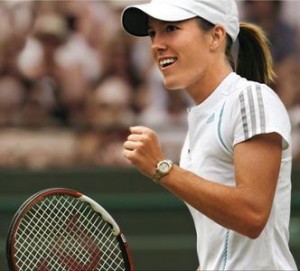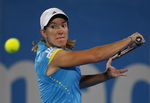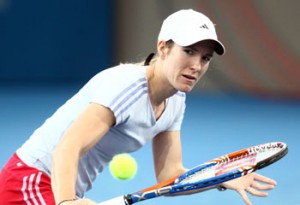Justine Henin Is Back and Ready to Go

Justine Henin got her comeback off to a roaring start with a victory over number two seed Nadia Petrova.
As Justine Henin hesitantly watched Roger Federer win his first French Open Crown in 2009 after suffering so many devastating losses on the red clay of Roland Garros, she knew the tiny voice that called to her would never be stilled again.
As Federer collapsed to his knees in an emotional moment at the conclusion of his win over Swede Robin Soderling, Henin took to heart her own series of losses at the only slam that eluded her for so many years, Wimbledon—where Henin had played in her first major final on illustrious Centre Court.
The Belgian had something left to accomplish and it would wait no longer—the void missing needed to be filled. So Henin picked up her racket for the first time since she had walked away from tennis 20 months ago and began constructing her comeback in the sport that had sustained her when nothing else could fill the loss of her mother and her family.
At age 27, with seven grand slam titles and 41 singles trophies, Henin will make her first appearance at Brisbane where she will face stiff competition against Russian Nadia Petrova seeded No. 2 in this Australian Open Series Tournament.
The No. 1 seed at Brisbane is fellow countrywoman Kim Clijsters who made her way out of retirement last year and astonished the world by winning the 2009 U.S. Open. Seeing Clijsters make good had to give Henin confidence that it was possible to come back strong—maybe even stronger than when she left.
Henin’s History
Henin stunned the tennis world by announcing her retirement from the game just prior to the onset of the 2008 French Open. Then only 25-years-of-age, Henin was ranked No. 1 in the world. No one was talking about her demise because her game was still rock solid. In fact, she was expected to repeat as the 2008 French Open Champion.
Fiercely competitive, Henin’s game remained coiled like a spring within her small frame. When unleashed she delivered a stunning blow. Not exactly considered a sweetheart, Henin was often seen as cocky and self-assured. She learned to serve bullets and had one of the best single-handed backhands in tennis, male or female.
Because of her accuracy, speed, and arsenal of weapons, including her delicate but athletic net-play ability many considered the equivalent of Federer. Of all her ground strokes, however, her forehand was considered her weapon of choice.
John McEnroe remained one of her biggest fans throughout her career because of her sheer competence and determination. She maximized every part of her game and found ways to win over power standing on the other side of the net.

Henin was the number one player in the world at the time of her surprise retirement in May 2008.
Even in the best of times for the young Belgian, it was hard to dismiss the vulnerability hiding just beneath the bold front. Masked by her intense bravado, Henin sheltered a shy and insecure little girl.
What Henin discovered upon self examination was that she played tennis to avoid life—it was her escape valve from an intensely unhappy personal situation.
Ever since her mother passed away when Henin was 12 years old, she and her father bordered on incompatibility. They could not agree on anything, especially Henin’s love and desire to play tennis.
Henin’s mother was always a staunch supporter of Justine’s tennis and her father’s disapproval deepened the wedge between them. The final straw came when he objected to Henin’s choice of boyfriends. They had a permanent parting of the ways over Justine’s attachment, and later marriage, to Pierre-Yves Hardenne in 2002.
But just as she was severing ties with her father, Henin was welcoming a very positive person and force into her life—Carlos Rodriguez became her coach shortly after her mother’s death in 1995. Soon he became like a second father to her, serving her not only as a guide on the court but also offering her support in her personal life.
2003
Justine was driven to succeed. In 2003, she began the year ranked as No. 5 and ended the year as the No. 1 player in women’s tennis.
In fact, 2003 became the turning point in her career, but it did not bode well at the beginning as she lost to fellow countrywoman Kim Clijsters in the semifinals of the Medibank International Series in Sydney—then lost to Venus Williams in straight sets in the semifinals of the Australian Open.
A breakthrough came in Dubai where Henin defeated Monica Seles for the first time in her career—4-6, 7-6, 7-5. Another momentous victory came when Henin defeated Serena Williams, then current world No. 1, at the Family Circle Cup Championships in South Carolina. It was Serena’s first defeat after 22 wins.
The high point came at the French Open where Henin defeated Kim Clijsters in the final in straight sets. She won her first grand slam title and became the first Belgian ever to win a major singles title.
She met Clijsters again in the 2003 U.S. Open final and again defeated her in straight sets. The win cemented Henin as the No. 2 player in the world, just behind Kim Clijsters.
2004
It was her victory at the Australian Open in 2004 that marked her permanent arrival, catapulting her over the top as she achieved not only the No. 1 ranking but in the process accumulated 7,626 points, the highest in the history of the WTA rankings. Many said that this mark could never be equaled.
Unfortunately, nothing is easily won or lasting in the professional game. Her health began to falter. The remainder of 2004 became a black hole for Henin as she lost her ranking and spent much of it trying to recover her health.
Through it all, with her coach by her side, Henin never quit believing—and in her mind she knew she would succeed again to the top of the game.

Henin has won seven grand slam titles with only Wimbledon so far eluding her grasp.
2005
It took her until the 2005 French Open to regain her form. In the final, she defeated Mary Pierce in a lopsided contest, 6-1, 6-1. She had entered the tournament as the No. 10 seed. The win moved her up to No. 7 in the WTA rankings. She remained perfect on clay.
A hamstring injury depleted her for the rest of 2005. The injuries and the resulting time off did nothing to improve Henin’s spirits or temper her struggle on and off court, where her personal life was beginning to fail.
2006
2006 found Henin returned to the game anticipating her own rise back to the top. She reached the Australian Open finals. Unfortunately, she retired in her final match with Amelie Mauresmo due to a stomach ailment. She was severely criticized for this because no one retires in a grand slam final.
Henin won the French Open again in 2006, defeating Kim Clijsters but lost the Wimbledon final to Mauresmo. Henin also lost the U.S. Open final to Maria Sharapova—but in making the finals became the first woman since Martina Hingis in 1997 to reach the finals of all four majors in a calendar year.
She ended 2006 as the No. 1 player by reaching the finals of the WTA Championship, where she defeated Mauresmo—Henin’s first win in this event. While victories on court were converging to propel Henin back into the tennis spotlight, her personal life was plummeting to an all-time low.
2007
In January of 2007, Henin withdrew from the Australian Open and announced to the world that her four-year marriage was over. 2007 would also see Henin reunited with her estranged family, openly embracing their participation in her life again.
In 2007, Henin captured another French Open title as well as another U.S. Open championship. She won both without dropping a set. In fact, she had not lost a set at the French since 2004.
In October of 2007, she sewed up the year-end ranking as No. 1 for the third time in her career. To cap it off, she won the WTA Championship to repeat her feat of 2006. She was undefeated after Wimbledon and the only woman to accomplish that since Graf in 1989.
2008
She started 2008 as the No. 1 player and in March became the seventh female player to hold the No. 1 ranking for 12 consecutive months.
However, she lost the Australian Open to the eventual champion, Maria Sharapova, in the quarterfinals. She was struggling, losing other early matches unexpectedly, and finally she withdrew from the Family Circle Cup citing fatigue.
Abruptly, she announced her retirement from tennis on May 14, 2008 and requested that her name be removed immediately from the WTA rankings. She was still ranked No. 1 and still expected by most to win the upcoming French Championships.
She was reunited with her family and felt at peace with her inner demons. Henin felt she could leave the game that sustained her for so long. Life called her out, and she went willingly.

Henin began her comeback season at Brisbane.
2010
Now Henin is fired up and ready to resume her tennis career with the rest of her life in order. She wants to win that elusive Wimbledon crown and compete with the best tennis has to offer.
Tennis no longer supplants her life but becomes a part of it. She faces a bucket load of expectation and the press will hit her hard if she falters. She has admitted to nerves but is ready to make a slow but deliberate climb back to the top.
It all begins in Brisbane and we have no idea how long it will last, what the result will be or when it will end. Let us hope Henin will be around for a long time and provide her brand of stiff and unyielding competition in the women’s game again…
PS: Henin won her opening match defeating Nadia Petrova, the No. 2 seed, 7-5, 7-5
[Much of the background information I took from an earlier article I wrote on Henin at the time of her retirement.]















